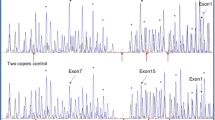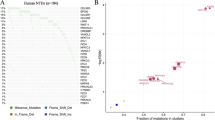Abstract
Extensive studies that have sought causative mutation(s) for neural tube defects (NTDs) have yielded limited positive findings to date. One possible reason for this is that many studies have been confined to analyses of germline mutations and so may have missed other, non-germline mutations in NTD cases. We hypothesize that somatic mutations of planar polarity pathway (PCP) genes may play a role in the development of NTDs. Torrent™ Personal Genome Machine™ (PGM) sequencing was designed for selected PCP genes in paired DNA samples extracted from the tissues of lesion sites and umbilical cord from 48 cases. Sanger sequencing was used to validate the detected mutations. The source and distribution of the validated mutations in tissues from different germ layers were investigated. Subcellular location, western blotting, and luciferase assays were performed to better understand the effects of the mutations on protein localization, protein level, and pathway signaling. ix somatic mutations were identified and validated, which showed diverse distributions in different tissues. Three somatic mutations were novel/rare: CELSR1 p.Gln2125His, FZD6 p.Gln88Glu, and VANGL1 p.Arg374His. FZD6 p.Gln88Glu caused mislocalization of its protein from the cytoplasm to the nucleus, and disrupted the colocalization of CELSR1 and FZD6. This mutation affected non-canonical WNT signaling in luciferase assays. VANGL1 p.Arg374His impaired the co-localization of CELSR1 and VANGL1, increased the protein levels of VANGL1, and influenced cell migration. In all, 7/48 (14.5%) of the studied NTD cases contained somatic PCP mutations. Somatic mutations in PCP genes (e.g., FZD6 and VANGL1) are associated with human NTDs, and they may occur in different stages and regions during embryonic development, resulting in a varied distribution in fetal tissues/organs.






Similar content being viewed by others
Data availability
The datasets for this manuscript are not publicly available for ethical and legal reasons. Requests to access the datasets should be directed to LW at linlinwang@bjmu.edu.cn.
References
Allache R, De Marco P, Merello E, Capra V, Kibar Z (2012) Role of the planar cell polarity gene CELSR1 in neural tube defects and caudal a genesis. Birth Defects Res A Clin Mol Teratol 94:176–181. https://doi.org/10.1002/bdra.23002
Bartsch O, Kirmes I, Thiede A, Lechno S, Gocan H, Florian IS, Haaf T, Zechner U, Sabova L, Horn F (2012) Novel VANGL1 gene mutations in 144 Slovakian, Romanian and German patients with neural tube defects. Mol Syndromol 3:76–81. https://doi.org/10.1159/000339668
Bastock R, Strutt H, Strutt D (2003) Strabismus is asymmetrically localised and binds to Prickle and Dishevelled during Drosophila planar polarity patterning. Development 130:3007–3014. https://doi.org/10.1242/dev.00526
Beck JA, Poulter M, Campbell TA, Uphill JB, Adamson G, Geddes JF, Revesz T, Davis MB, Wood NW, Collinge J (2004) Somatic and germline mosaicism in sporadic early-onset Alzheimer’s disease. Hum Mol Genet 13:1219–1224. https://doi.org/10.1093/hmg/ddh134
Copp AJ, Greene ND (2010) Genetics and development of neural tube defects. J Pathol 220:217–230. https://doi.org/10.1002/path.2643
De Marco P, Merello E, Rossi A, Piatelli G, Cama A, Kibar Z, Capra V (2012) FZD6 is a novel gene for human neural tube defects. Hum Mutat 33:384–390. https://doi.org/10.1002/humu.21643
De Marco P, Merello E, Consales A, Piatelli G, Cama A, Kibar Z, Capra V (2013) Genetic analysis of disheveled 2 and disheveled 3 in human neural tube defects. J Mol Neurosci 49:582–588. https://doi.org/10.1007/s12031-012-9871-9
Devenport D, Fuchs E (2008) Planar polarization in embryonic epidermis orchestrates global asymmetric morphogenesis of hair follicles. Nat Cell Biol 10:1257–1268. https://doi.org/10.1038/ncb1784
Devenport D, Oristian D, Heller E, Fuchs E (2017) Corrigendum: mitotic internalization of planar cell polarity proteins preserves tissue polarity. Nat Cell Biol 19:143. https://doi.org/10.1038/ncb3469
Erickson RP (2010) Somatic gene mutation and human disease other than cancer: an update. Mutat Res 705:96–106. https://doi.org/10.1016/j.mrrev.2010.04.002
Greene ND, Stanier P, Copp AJ (2009) Genetics of human neural tube defects. Hum Mol Genet 18:R113–129. https://doi.org/10.1093/hmg/ddp347
Harris MJ, Juriloff DM (2010) An update to the list of mouse mutants with neural tube closure defects and advances toward a complete genetic perspective of neural tube closure. Birth Defects Res A Clin Mol Teratol 88:653–669. https://doi.org/10.1002/bdra.20676
Henrique D, Abranches E, Verrier L, Storey KG (2015) Neuromesodermal progenitors and the making of the spinal cord. Development 17:2864–2875. https://doi.org/10.1242/dev.119768
Jamuar SS, Lam AT, Kircher M, D'Gama AM, Wang J, Barry BJ, Zhang X, Hill RS, Partlow JN, Rozzo A et al (2014) Somatic mutations in cerebral cortical malformations. N Engl J Med 371:733–743. https://doi.org/10.1056/NEJMc1411784
Juriloff DM, Harris MJ (2012) A consideration of the evidence that genetic defects in planar cell polarity contribute to the etiology of human neural tube defects. Birth Defects Res A Clin Mol Teratol 94:824–840. https://doi.org/10.1002/bdra.23079
Katoh M (2002) Molecular cloning and characterization of Strabismus 2 (STB2). Int J Oncol 20:993–998. https://doi.org/10.3892/ijo.20.5.993
Katoh Y, Katoh M (2005) Comparative genomics on Vangl1 and Vangl2 genes. Int J Oncol 26:1435–1440. https://doi.org/10.3892/ijo.26.5.1435
Kibar Z, Torban E, McDearmid JR, Reynolds A, Berghout J, Mathieu M, Kirillova I, De Marco P, Merello E, Hayes JM (2007) Mutations in VANGL1 associated with neural-tube defects. N Engl J Med 356:1432–1437. https://doi.org/10.1056/NEJMoa060651
Knudson AG Jr (1971) Mutation and cancer: statistical study of retinoblastoma. Proc Natl Acad Sci USA 68:820–823. https://doi.org/10.1073/pnas.68.4.820
Kolligs FT, Hu G, Dang CV, Fearon ER (1999) Neoplastic transformation of RK3E by mutant beta-catenin requires deregulation of Tcf/Lef transcription but not activation of c-myc expression. Mol Cell Biol 19:5696–5706. https://doi.org/10.1128/mcb.19.8.5696
Krzyzanowski A, Kwiatek M, Geca T, Stupak A, Kwasniewska A (2019) Modern ultrasonography of the umbilical cord: prenatal diagnosis of umbilical cord abnormalities and assessement of fetal wellbeing. Med Sci Monit 25:3170–3180. https://doi.org/10.12659/MSM.913762
Lee JH, Huynh M, Silhavy JL, Kim S, Dixon-Salazar T, Heiberg A, Scott E, Bafna V, Hill KJ, Collazo A et al (2012) De novo somatic mutations in components of the PI3K-AKT3-mTOR pathway cause hemimegalencephaly. Nat Genet 44:941–945. https://doi.org/10.1038/ng.2329
Lei YP, Zhang T, Li H, Wu BL, Jin L, Wang HY (2010) VANGL2 mutations in human cranial neural-tube defects. N Engl J Med 362:2232–2235. https://doi.org/10.1056/NEJMc0910820
Lei YP, Zhu H, Yang W, Ross ME, Shaw GM, Finnell RH (2014) Identification of novel CELSR1 mutations in spina bifida. PLoS ONE 9:e92207. https://doi.org/10.1371/journal.pone.0092207
Lei YP, Fathe K, McCartney D, Zhu H, Yang W, Ross ME, Shaw GM, Finnell RH (2015) Rare LRP6 variants identified in spina bifida patients. Hum Mutat 36:342–349. https://doi.org/10.1002/humu.22750
Leija-Salazar M, Piette C, Proukakis C (2018) Review: somatic mutations in neurodegeneration. Neuropathol Appl Neurobiol 44:267–285. https://doi.org/10.1111/nan.12465
McConnell MJ, Moran JV, Abyzov A, Akbarian S, Bae T, Cortes-Ciriano I et al (2017) Intersection of diverse neuronal genomes and neuropsychiatric disease: the brain somatic mosaicism network. Science 356:6336. https://doi.org/10.1126/science.aal1641
Musci TS, Mullen RJ (2003) All-or-none craniorachischisis in loop-tail mutant mouse chimeras. Development 110:229–237
Poduri A, Evrony GD, Cai X, Walsh CA (2013) Somatic mutation, genomic variation, and neurological disease. Science 341:1237758. https://doi.org/10.1126/science.1237758
Schulte G, Bryja V (2007) The Frizzled family of unconventional G-protein-coupled receptors. Trends Pharmacol Sci 28:518–525. https://doi.org/10.1002/humu.21662
Shi OY, Yang HY, Shen YM, Sun W, Cai CY, Cai CQ (2014) Polymorphisms in FZD3 and FZD6 genes and risk of neural tube defects in a northern Han Chinese population. Neurol Sci 35:1701–1706. https://doi.org/10.1007/s10072-014-1815-4
Sorsa M (1980) Somatic mutation theory. J Toxicol Environ Health 6:977–982. https://doi.org/10.1080/15287398009529919
Strutt DI (2001) Asymmetric localization of Frizzled and the establishment of cell polarity in the Drosophila wing. Mol Cell 7:367–375. https://doi.org/10.1016/s1097-2765(01)00184-8
Suberbielle E, Sanchez PE, Kravitz AV, Wang X, Ho K, Eilertson K, Devidze N, Kreitzer AC, Mucke L (2013) Physiologic brain activity causes DNA double-strand breaks in neurons, with exacerbation by amyloid-beta. Nat Neurosci 16:613–621. https://doi.org/10.1038/nn.3356
Tinschert S, Naumann I, Stegmann E, Buske A, Kaufmann D, Thiel G, Jenne DE (2000) Segmental neurofibromatosis is caused by somatic mutation of the neurofibromatosis type 1 (NF1) gene. Eur J Hum Genet 8:455–459. https://doi.org/10.1038/sj.ejhg.5200493
Torban E, Wang HJ, Groulx N, Gros P (2004) Independent mutations in mouse Vangl2 that cause neural tube defects in looptail mice impair interaction with members of the Dishevelled family. J Biol Chem 279:52703–52713. https://doi.org/10.1074/jbc.M408675200
Torban E, Patenaude AM, Leclerc S, Rakowiecki S, Gauthier S, Andelfinger G, Epstein DJ, Gros P (2008) Genetic interaction between members of the Vangl family causes neural tube defects in mice. Proc Natl Acad Sci USA 105:3449–3454. https://doi.org/10.1073/pnas.0712126105
Veeman MT, Axelrod JD, Moon RT (2003a) A second canon. Functions and mechanisms of beta-catenin-independent Wnt signaling. Dev Cell 5:367–377. https://doi.org/10.1016/s1534-5807(03)00266-1
Veeman MT, Slusarski DC, Kaykas A, Louie SH, Moon RT (2003b) Zebrafish prickle, a modulator of noncanonical Wnt/Fz signaling, regulates gastrulation movements. Curr Biol 13:680–685. https://doi.org/10.1016/s0960-9822(03)00240-9
Violet M, Chauderlier A, Delattre L, Tardivel M, Chouala MS, Sultan A, Marciniak E, Humez S et al (2015) Prefibrillar Tau oligomers alter the nucleic acid protective function of Tau in hippocampal neurons in vivo. Neurobiol Dis 82:540–551. https://doi.org/10.1016/j.nbd.2015.09.003
Wallingford JB, Niswander LA, Shaw GM, Finnell RH (2013) The continuing challenge of understanding, preventing, and treating neural tube defects. Science 339:1222002. https://doi.org/10.1126/science.1222002
Wang Y, Guo N, Nathans J (2006) The role of Frizzled3 and Frizzled6 in neural tube closure and in the planar polarity of inner-ear sensory hair cells. J Neurosci 26:2147–2156. https://doi.org/10.1523/JNEUROSCI.4698-05.2005
Wang L, Lin S, Yi D, Huang Y, Wang C, Jin L, Liu J, Zhang Y, Ren A (2017) Apoptosis, expression of PAX3 and P53, and caspase signal in fetuses with neural tube defects. Birth Defects Res 109:1596–1604. https://doi.org/10.1002/bdr2.1094
Xu YK, Nusse R (1998) The Frizzled CRD domain is conserved in diverse proteins including several receptor tyrosine kinases. Curr Biol 8:R405–406. https://doi.org/10.1016/s0960-9822(98)70262-3
Ybot-Gonzalez P, Savery D, Gerrelli D, Signore M, Mitchell CE, Faux CH, Greene ND, Copp AJ (2007) Convergent extension, planar-cell-polarity signalling and initiation of mouse neural tube closure. Development 134:789–799. https://doi.org/10.1242/dev.000380
Funding
This work was supported by the National Natural Science Foundation of China (Grant No. 81773441). Dr. Richard Finnell was supported in part by funds made available from the William T. Butler, M.D., Distinguished Chair endowment at Baylor College of Medicine and a grant from the National Institutes of Health (HD081216).
Author information
Authors and Affiliations
Contributions
LW, YL, and AR conceptualized the study; LW supervised the implementation and drafted the manuscript; TT conducted the functional study and drafted the manuscript; YL provided critical guidance on the functional study and interpretation of the results; YC helped with bench work; MK performed the cell migration assay; LJ participated in subject enrollment; and RHF critically revised the manuscript.
Corresponding authors
Ethics declarations
Conflict of interest
The authors declare that they have no conflict of interests.
Ethical approval
The study protocol was approved by the institutional review board of Peking University (Beijing, China, IRB00001052-18082).
Informed consent
Written informed consent was obtained from all of the mothers prior to the beginning of the investigation.
Additional information
Publisher's Note
Springer Nature remains neutral with regard to jurisdictional claims in published maps and institutional affiliations.
Electronic supplementary material
Below is the link to the electronic supplementary material.
Rights and permissions
About this article
Cite this article
Tian, T., Lei, Y., Chen, Y. et al. Somatic mutations in planar cell polarity genes in neural tissue from human fetuses with neural tube defects. Hum Genet 139, 1299–1314 (2020). https://doi.org/10.1007/s00439-020-02172-0
Received:
Accepted:
Published:
Issue Date:
DOI: https://doi.org/10.1007/s00439-020-02172-0




